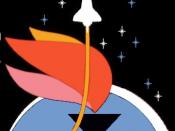This paper discusses the environmental and human decision making factors that were associated with the launching of the Space Shuttle Challenger on January 28, 1986. It mentions some details of those on board and why it was widely televised. Shortly after launch, the Shuttle exploded destroying the vehicle and all crew members. The cause and contributing factors that lead to the Challenger tragedy are explored in detail. There is some focus put on NASA's group decision support system (GDSS) discussing their meetings and the decision to launch.
Space Travel, is a sense of national pride for many Americans. If you ask anyone who was alive at the time, they could probably tell you exactly where they were when they heard that Neil Armstrong was the first person to walk on the Moon. But all of the success in our space programs is overshadowed by tragedy. On January 28, 1986, one of the worst disasters in our space program's history occurred.
Many people were watching at the moment because it was the highly televised space mission. For the first time, a civilian was a member of the crew that was to be shot into space. This civilian was the winner of the "Teacher in Space" contest, Christa McAuliffe. The disaster: the explosion of the Space Shuttle Challenger, (Compton's, 1). The STS 51-L mission was to deploy the second Tracking and Data Relay Satellite and the Spartan Halley's Comet observer. Paramount to this mission was crew member S. Christa McAuliffe - the first Space Shuttle passenger/observer participating in the NASA Teacher in Space Program. Ms. McAuliffe would have conducted live educational broadcasts from the Shuttle and transmitted them to classrooms throughout the world. The loss of life and the unique position that symbolized Christa McAuliffe as the first civilian working as...



Too much of quote
this is a good essay but it was used too many quote, essay need to show your thinking, do not put a lot of quote in there. thanks
1 out of 1 people found this comment useful.